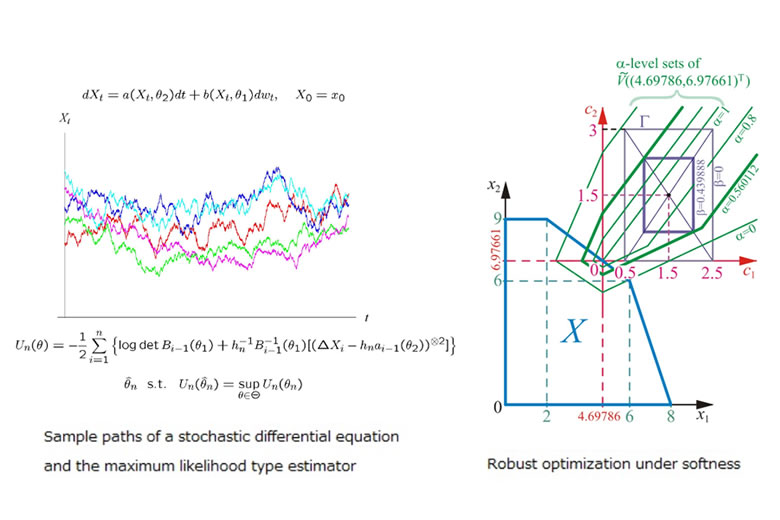Department of Systems Innovation
The Department of Systems Innovation aims at interdisciplinary education and research to train the skilled people who can play an important part in the progress of the current information society with the wide knowledge ranging from device engineering to systems integration. In this department, education and research covering a wide range from hardware technology to systems design and analysis, such as electronics, systems science and mathematical science, are carried out. This department is composed of the Division of Advanced Electronics and Optical Science, the Division of Systems Science and Applied Informatics, the Division of Mathematical Science, and the Division of Mathematical Sciences for Social Systems newly started as an interdisciplinary division.
The Division of Advanced Electronics and Optical Science is mainly devoted to develop novel electronics technology which serves as a base of the developing a high information society. In this division, education and research in advanced technology extending from nanoelectronics to echo-friendly electronics, such as novel solid state devices and processing, functional quantum devices and quantum information, optical and quantum electronics, are carried out.
The Division of Systems Science and Applied Informatics aims to obtain intelligence and high quality functions for rapidly growing and complicated systems. It focuses on the education and research of basic theories and their applications which offer tools for analysis and design of intelligent systems and complicated systems, where human beings play important roles, by integrating system theory, information processing, media, sensing, and robotics technologies.
The Division of Mathematical Science carries out training and research in order to understand practical phenomena which occur in the fields of natural science, social science, technology, medical science and so on. The methodologies are concocted by constructing mathematical models, analyzing them, diagnosing the models and reanalyzing them based on the recent development of computer hardware and software. The Division of Mathematical Sciences for Social Systems is concerned mainly with research and education in advanced mathematical approaches to analyze and design complicated social systems, such as financial economics and networked society by integrating stochastic analysis, statistical inference and decision theory, systems theory, and operations research.
Division of Advanced Electronics and Optical Science
 The future prospects for society in the twenty first century are to construct a stable network of information and energy with high quality. This division is devoted firstly to the creation and innovation of new structures, new phenomena and new functions related to electronic and photonic devices, and the elucidation of phisics of materials used in the devices. Next, advanced research and development of process technology and device design are being carried out widely. Moreover, the smart system, utilizing the developed devices, is created for the human interface. By education through these research, excellent researchers and technical experts supporting future science and civilization as well as fusion of science and technology are cultivated.
The future prospects for society in the twenty first century are to construct a stable network of information and energy with high quality. This division is devoted firstly to the creation and innovation of new structures, new phenomena and new functions related to electronic and photonic devices, and the elucidation of phisics of materials used in the devices. Next, advanced research and development of process technology and device design are being carried out widely. Moreover, the smart system, utilizing the developed devices, is created for the human interface. By education through these research, excellent researchers and technical experts supporting future science and civilization as well as fusion of science and technology are cultivated.
| DIVISION | AREA | GROUP |
|---|---|---|
| Division of Advanced Electronics and Optical Science | Area of Solid State Electronics | Nano-electronics Group |
| Nanostructure Physics Group | ||
| Nano-physics Device Group | ||
| Area of Advanced Quantum Devices and Electronics | Quantum Computing Group | |
| Area of Optical Electronics | Microwave Photonics Group | |
| Digital Photonics Group | ||
| Molecular Photonics for Medicine Group | ||
| Center for Science and Technology under Extreme Conditions | Advanced Electronics Under Extreme Conditions |
Division of Systems Science and Applied Informatics
 This division aims to obtain intelligence and high quality functions for rapidly grown and complicated systems.According to our educational policy, graduate students are qualified to obtain various aspects of knowledge on systems science and powerful computer literacy based on applied mathematics, technical English, a variety of liberal arts, and to master the abilities of developing unique ideas with their own observations, making persuasive presentaion, and creating a new area of engineering science.
This division aims to obtain intelligence and high quality functions for rapidly grown and complicated systems.According to our educational policy, graduate students are qualified to obtain various aspects of knowledge on systems science and powerful computer literacy based on applied mathematics, technical English, a variety of liberal arts, and to master the abilities of developing unique ideas with their own observations, making persuasive presentaion, and creating a new area of engineering science.
| DIVISION | AREA | GROUP |
|---|---|---|
| Division of Systems Science and Applied Informatics | Area of System Theory | Systems Analysis Group |
| Robot Mechanisms Group | ||
| Area of Intelligent Systems | Social Robotics Group | |
| Intelligent Robotics Group | ||
| Extended Reality | ||
| Robotic Manipulation Group |
Division of Mathematical Science
 Mathematical Science is the science in which mathematical and statistical models are constructed, developed mathematically and analyzed empirically in order to understand practical phenomena which occur in the fields of natural science, social science, technology, biology and so forth. For the purpose, one needs to utilize computers with advanced levels to make computer simulations, computer graphics and to develop algorithms, among others. This division consists of two large groups. One is a group of applied mathematics and the other, a group of statistical science, each having two smaller subgroups. In this division, emphasis is placed on research and education of differential equations, mathematical physics, statistical analysis and data science.
Mathematical Science is the science in which mathematical and statistical models are constructed, developed mathematically and analyzed empirically in order to understand practical phenomena which occur in the fields of natural science, social science, technology, biology and so forth. For the purpose, one needs to utilize computers with advanced levels to make computer simulations, computer graphics and to develop algorithms, among others. This division consists of two large groups. One is a group of applied mathematics and the other, a group of statistical science, each having two smaller subgroups. In this division, emphasis is placed on research and education of differential equations, mathematical physics, statistical analysis and data science.
| DIVISION | AREA | GROUP |
|---|---|---|
| Division of Mathematical Science | Area of Mathematical Modelling | Diffetential Equation Group |
| Applied Analysis Group | ||
| Area of Statistical Science | Statistical Analysis Group Group | |
| Data Science Research Group |
Division of Mathematical Science for Social Systems
 The development of science and technology which copes with rationalization and internationalization of financial assets management could be done through research of financial engineering and mathematical finance. To analyze random and complex fluctuation according to time development and consider optimization under such random phenomena, we need the latest results of advanced mathematics concerning the theory of stochastic differential equations or statistical inference. Moreover, when we apply the theoretical results to actual technology for capital assets management, techniques of numerical analysis on a large scale at high speed are indispensable. On the other hand, due to the recent rapid technological advances in computer engineering, large scale networked systems and embedded systems with high quality functions have been developed. To analyze, design, and control such systems, extensions of the systems theory and optimization theory are required. Moreover, computational intelligence techniques are important for developing flexible intelligent systems. In a division of mathematical science for social systems, we achieve the education of competent persons who contribute to the development of such technology by means of advanced mathematical methods and also research development.
The development of science and technology which copes with rationalization and internationalization of financial assets management could be done through research of financial engineering and mathematical finance. To analyze random and complex fluctuation according to time development and consider optimization under such random phenomena, we need the latest results of advanced mathematics concerning the theory of stochastic differential equations or statistical inference. Moreover, when we apply the theoretical results to actual technology for capital assets management, techniques of numerical analysis on a large scale at high speed are indispensable. On the other hand, due to the recent rapid technological advances in computer engineering, large scale networked systems and embedded systems with high quality functions have been developed. To analyze, design, and control such systems, extensions of the systems theory and optimization theory are required. Moreover, computational intelligence techniques are important for developing flexible intelligent systems. In a division of mathematical science for social systems, we achieve the education of competent persons who contribute to the development of such technology by means of advanced mathematical methods and also research development.
| DIVISION | AREA | GROUP |
|---|---|---|
| Division of Mathematical Science for Social Systems | Area of Mathematical and Statistical Finance | Research Group of Statistical Inference |
| Research Group of Mathematical Modeling in Finance | ||
| Research Group of Stochastic Analysis | ||
| Research Group of Stochastic Processes | ||
| Area of Theoretical Systems Science | Control Information Systems | |
| Research Group of Systems Optimization and Decision Making |